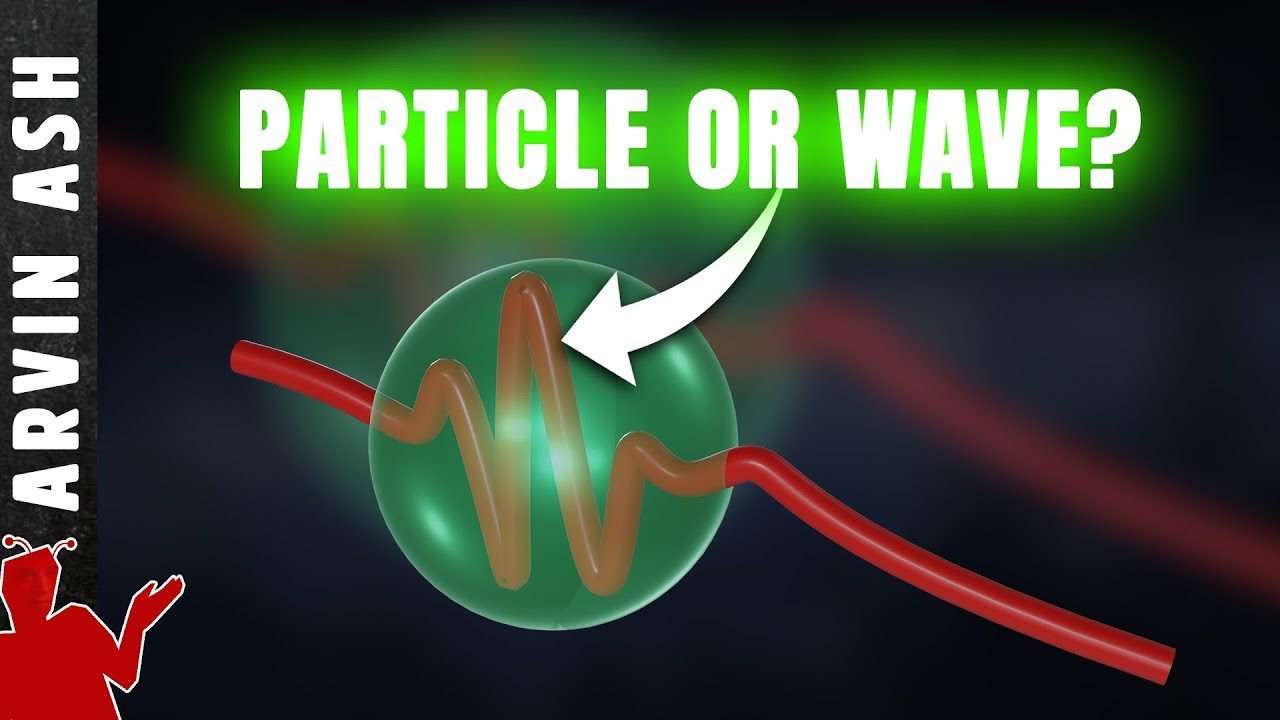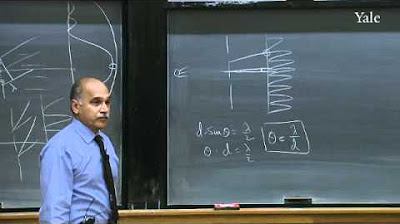Why don't quantum effects occur in large objects? double slit experiment with tennis balls
TLDRThe video script delves into the peculiar behavior of quantum particles, such as photons and electrons, which exhibit wave-like properties when unobserved but become distinct particles upon measurement. It explores the double-slit experiment and the concept of particle entanglement, highlighting the transition from quantum to classical behavior as particle size increases. The script challenges the viewer to consider the implications of quantum mechanics in everyday life and the interconnectedness of all objects with the universe at a fundamental level.
Takeaways
- 🌀 Quantum mechanics reveals strange behavior in small particles like photons, electrons, and atoms.
- 🔍 Observation and measurement in quantum mechanics are synonymous, affecting the behavior of particles.
- 🎢 The double-slit experiment shows that unobserved particles behave like waves of probability, but upon measurement, they collapse into distinct particles.
- 🔗 Quantum entanglement demonstrates particles connected through shared probability waves, regardless of the distance separating them.
- 🤔 Macroscopic objects like tennis balls do not exhibit quantum behavior because they are impossible to isolate informationally from the environment.
- 💡 Any record of a particle's path in the universe, even if destroyed, causes the probability wave to collapse, eliminating wave-like behavior.
- 🧪 Quantum behavior in larger particles is hindered by the need for informational isolation, which is practically impossible to achieve.
- 📉 The de Broglie wavelength indicates that larger objects have such small quantum effects that their quantum behavior converges with classical behavior.
- 🚫 Macroscopic objects cannot be in superposition or exhibit entanglement due to their inherent connection to the universe and inability to maintain path secrecy.
- 🌌 Quantum mechanics operates in a realm unseen and unknown, making it mysterious and distinct from everyday experiences.
- 📚 Learning about quantum mechanics can lead to a deeper understanding of the interconnectedness of the universe and our place within it.
Q & A
What is the main theme of the video script?
-The main theme of the video script is the exploration of quantum mechanics, specifically focusing on the strange behavior of subatomic particles and the transition from quantum to classical behavior in larger objects.
What is the double-slit experiment and what does it demonstrate about the nature of particles?
-The double-slit experiment is a classic physics experiment that demonstrates the dual nature of particles like photons, electrons, and atoms. It shows that these particles behave as waves of probability when not measured, but collapse into distinct particles upon observation or measurement.
What is the delayed choice quantum eraser experiment and how does it relate to particle entanglement?
-The delayed choice quantum eraser experiment is a more advanced quantum mechanics experiment that further explores the concept of entanglement. It shows that two particles can be intimately connected through the sharing of one probability wave, regardless of the distance separating them in space-time.
Why don't macroscopic objects like a tennis ball exhibit quantum behavior?
-Macroscopic objects like a tennis ball do not exhibit quantum behavior because they are nearly impossible to isolate informationally from the outside world. Any interaction with the environment, no matter how small, can cause the quantum wave function to collapse, resulting in classical behavior.
What is the Copenhagen interpretation of quantum mechanics?
-The Copenhagen interpretation, proposed by Niels Bohr and Werner Heisenberg, is the most accepted interpretation of quantum mechanics. It posits that particles are not particles at all, but exist in multiple states simultaneously as waves of probabilities. These waves only become distinct particles upon measurement or observation.
What is meant by the 'collapse' of the probability wave?
-The 'collapse' of the probability wave refers to the point at which the wave function of a quantum system transitions from a state of superposition, where it exists in multiple states simultaneously, to a definite state with a single outcome upon measurement or observation.
How does the concept of 'informational isolation' relate to quantum behavior?
-Informational isolation is crucial for maintaining the quantum behavior of particles. For a particle to remain in a state of superposition, its path information must be kept in absolute secrecy, meaning no record of its path can be made in the universe, even if no one ever observes it.
What is the de Broglie wave function and how does it relate to the quantum behavior of macroscopic objects?
-The de Broglie wave function describes the wave-like nature of particles and is given by the formula Lambda equals Planck's constant over mass times velocity. For macroscopic objects with large mass, the wavelength is extremely small, leading to negligible interference patterns and thus, their quantum behavior converges to classical behavior.
Why is it considered a mistake to extrapolate quantum mechanics observations to everyday experiences?
-It is a mistake to extrapolate quantum mechanics observations to everyday experiences because macroscopic objects behave very differently from subatomic particles. Quantum mechanics describes a world that is fundamentally different from our macroscopic, everyday experiences, and the principles that govern the microscopic realm do not necessarily apply to the macroscopic world.
What are some advanced topics in quantum mechanics discussed in the video script?
-Some advanced topics in quantum mechanics discussed in the video script include quantum computing, quantum cloning, and entanglement.
How does the video script relate to the concept of our intimacy with the universe?
-The video script suggests that our every move and thought is recorded in the particles around us and within us, making us informationally one with the universe. This highlights our deep connection with the forces and particles that make up our existence.
Outlines
🌀 Quantum Behavior and the Double Slit Experiment
This paragraph introduces the peculiar behavior of quantum particles such as photons, electrons, and atoms, highlighting the double slit experiment as a prime example. It explains how these particles behave like waves of probability until measured, at which point they collapse into distinct particles. The concept of entanglement is also mentioned, where particles appear to be intimately connected despite spatial separation. The paragraph poses questions about the transition from quantum to classical behavior and sets the stage for an explanation of this quantum 'cutoff'.
🔍 The Mystery of Quantum Measurement
This section delves into the concept of measurement in quantum mechanics, emphasizing that it's not about conscious observation but any physical record of a particle's path. It explains that even if the information is destroyed, the act of recording creates a universe-wide record that collapses the probability wave into a particle. The paragraph discusses the challenges of isolating large particles like tennis balls to prevent them from displaying quantum behavior, due to their constant interaction with the environment.
🌟 Quantum Mechanics and Macro Objects
The final paragraph discusses the applicability of quantum mechanics to all objects, regardless of size, and the theoretical possibility of macro objects like tennis balls exhibiting quantum behavior if they could be perfectly isolated. However, it explains the practical impossibility of this due to the vast size and mass of macro objects, which makes their quantum behavior indistinguishable from classical physics. The paragraph concludes by emphasizing the intimate connection between macro objects and the universe, as every action and thought is recorded in the fabric of the universe.
Mindmap
Keywords
💡Quantum Mechanics
💡Double Slit Experiment
💡Wave Function Collapse
💡Entanglement
💡Copenhagen Interpretation
💡Superposition
💡Measurement Problem
💡Classical Behavior
💡Macroscopic Objects
💡De Broglie Wave Function
Highlights
Quantum mechanics reveals strange behavior of smallest particles like photons, electrons, and atoms.
Observation and measurement are synonymous in the context of quantum mechanics.
The double-slit experiment demonstrates wave-like probability behavior when particles are not measured.
In the double-slit experiment, measuring particles causes their probability waves to collapse, turning them into distinct particles.
Quantum entanglement shows particles can be intimately connected despite being separated in space-time.
Macroscopic objects like tennis balls do not exhibit quantum behavior.
Quantum behavior has been observed in molecules containing hundreds to thousands of atoms.
The transition from quantum to classical behavior is marked by a cutoff that is not well understood.
The Copenhagen interpretation of quantum mechanics suggests particles are like clouds of probabilities.
The collapse of the probability wave occurs when the particle's path information is measured or recorded.
Measurement in quantum mechanics is the formation of a physical record of a particle's path, regardless of observation.
Large objects like tennis balls cannot be informationally isolated from the universe, preventing quantum superposition.
Isolating a macroscopic object like a tennis ball would require removing all air, photons, and cooling it to near absolute zero.
The de Broglie wavelength of large objects is extremely small, leading to negligible interference patterns.
Quantum mechanics applies to all objects regardless of size, but practical applications are limited to microscopic scales.
Macroscopic objects cannot be entangled in the same way as microscopic particles due to their size and isolation challenges.
Quantum mechanics is mysterious because it seems to only operate when no one is looking or able to determine the outcome.
Macroscopic objects are intimately connected to the universe, with every move and thought recorded in the particles around and within them.
Transcripts
5.0 / 5 (0 votes)
Thanks for rating:





